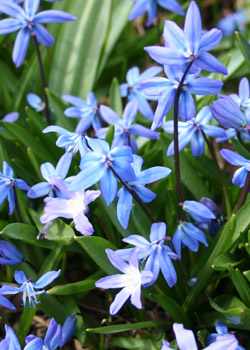Scilla/Squill Bulbs Information

The genus, Scilla is a group of early spring blooming bulbs which contains more than 100 species! The bright blue flowers of the siberian squill are one of the first bulbs to bloom in the spring. The intense flowers of the squill (or scilla) sit on top of arching stalks and slightly nod above the dark green grass-like foliage. They are gorgeous when planted in masses and loose drifts in slightly shaded to full sun areas. They are great for attracting pollinating insects due to their soft, sweet fragrance. Fortunately, they are not bothered by deer and rodents!
Plant Information
- Planting Time: Fall
- Bloom Time: Early Spring
- Hardiness Zone: 3-8
- Suitable Zone: 3-9
- Light Needs: Partial - Full Sun
Planting Scilla
- Scilla are typically planted in fall. Their roots will form in fall and they will bloom in early spring. Like most bulbs, scilla do not enjoy sitting wet in the soil. Therefore, choose a location with well-drained soil that receives partial to full sun.
- Scilla work well for naturalizing a large area. To attain this look, simply map out an area you would like to naturalize and dig the entire area about 2-3" deep. Scatter the bulbs throughout the area for a natural look.
- If not naturalizing, plant the bulbs approximately 2-3" below the soil's surface. Dig holes for each bulb individually or dig a hole slightly larger and evenly space an odd number of bulbs in the bottom for more of a "bouquet" look.
- The bulbs of Scilla are slightly rounded with points on the tops; plant the bulbs so that these points are facing up to the surface of the soil.
- Thoroughly soak the area with water once all the bulbs have been planted. Roots will form in fall and then the bulb will sprout and bloom in spring. Water as needed while the plant is growing and blooming.
- After the flowers have died, allow the foliage to yellow and die back. The leaves will continue to gather sunlight and make food for next year's blooms.
- Once the foliage has yellowed and dried, the foliage may be removed by gently pulling it out of the soil. If the leaves do not easily pull away from the bulb, they are not ready to be removed. After the foliage has been removed, your scilla bulbs will be dormant and ready to "rest" until next year!